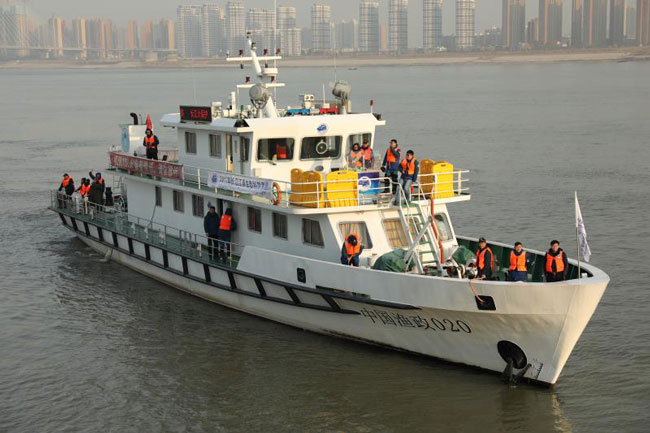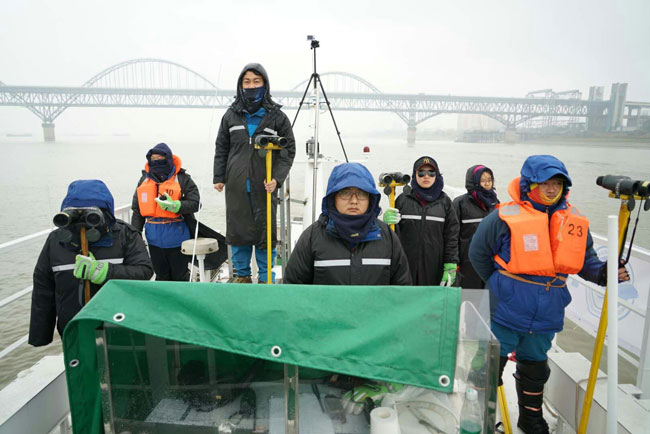
Newsroom
Rapid Decline Trend in Yangtze Finless Porpoise Has Been Restrained but Survival Situation is Still Grim

Started from November 10, 2017, the 52-day YFPE 2017 investigated 1,669km of the Yangtze River from Yichang to Shanghai and the appended Dongting and Poyang lakes. (Image by IHB)
The results of Yangtze Finless Porpoise Expedition 2017 (YFPE 2017) was officially released by the Ministry of Agriculture and Rural Affairs of China on July 24, 2018, showing that the rapid decline trend in the number of the Yangtze finless porpoise has been restrained, but the extremely endangered status of the population has not been changed. The protection situation is still grim.
The total population abundance of the Yangtze finless porpoise in 2017 was estimated to be approximately 1,012 - including 445 in the mainstream of the Yangtze River - a slight decrease but not significantly changed compared with that in 2012 (approximately 505 porpoises in the mainstream, 90 porpoises in Dongting Lake, and around 450 porpoises in Poyang Lake), the YFPE 2017 found.
The population of the Yangtze finless porpoise in Dongting Lake is about 110, according to the latest survey, which is a slight increase compared with that in 2012. The porpoise number in Poyang Lake remained relatively stable at around 457. From the distribution of the Yangtze finless porpoises, the current status of population patchiness has not changed significantly, tending to concentrate on river sections that are less disturbed by humans and better habitats.
Started from November 10, 2017, the 52-day YFPE 2017 investigated 1,669km of the Yangtze River from Yichang to Shanghai and the appended Dongting and Poyang lakes. It was a full-scale scientific expedition after Institute of Hydrobiology (IHB) of Chinese Academy of Sciences conducted the Yangtze Freshwater Dolphins Expedition in 2006 and 2012, and has great significance for the protection of Yangtze finless porpoise and the entire Yangtze River ecosystem.
The YFPE 2017 also conducted surveys of habitat quality, including investigations on the environmental factors such as sandbar development, shoreline environment, water quality, ship traffic, hydro-project construction, fishing and underwater noise, among others. The results show that the water quality of the main habitat of the Yangtze finless porpoise is acceptable and would not significantly affect the long-term survival of the population. The habitat quality of Poyang Lake is relatively better than Dongting Lake whereas the main stream was relatively poor.
“The Yangtze finless porpoise in the main channel prefer the habitats with natural slopes and gentle currents, showing the characteristics of distribution around the sandbar,” said IHB Prof. WANG Ding who led the expedition team. However, due to the direct or indirect effect of human activities - the illegal fishing and busy shipping in particular, these important habitats were being destroyed and the quality of the coastal habitat generally becomes worse. “We are now facing great pressure on the survival of the Yangtze finless porpoise.”
Based on the results of this investigation, IHB experts put forward specific suggestions for strengthening the protection of the Yangtze finless porpoise. “While strengthening the restoration and protection of the aquatic habitats, we suggest to strengthen the management and construction of nature reserves as well,” said Wang on behalf of his team. “More efforts shall be put on the upgrading of relevant protected areas and the establishment of new nature reserves of the Yangtze finless porpoise.”
The practice of ex-situ reserve of the Yangtze finless porpoise shall be continued and the ex-situ individuals shall be released into nature, according to IHB experts. Other measures include the establishment of a rescue, collection and filing system for the casualties; building up of a real-time underwater acoustic field monitoring and early warning network; and being more open to public participation in the protection of the Yangtze finless porpoise.
Supervised by the National Aquatic Wildlife Conservation Association, the YFPE 2017 was carried out by IHB under the leadership of Yangtze River Basin Fishery Supervision and Management Office, and Ministry of Agriculture and Rural Affairs. Participants from major research institutions of Yangtze River cetaceans, relevant nature reserves in the middle and lower reaches of the Yangtze River, local fishery administrations, related NGOs and volunteers joined this expedition. The Yangtze River Administration of Navigational Affairs, Yangtze River Maritime Safety Administration, and Yangtze River Shipping Public Security Bureau provided convenience for ship anchoring and logistical support of the entire scientific expedition.

The YFPE 2017 has great significance for the protection of Yangtze finless porpoise and the entire Yangtze River ecosystem. (Image by IHB)